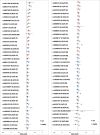A comprehensive examination of breast cancer risk loci in African American women
- PMID: 24852375
- PMCID: PMC4168823
- DOI: 10.1093/hmg/ddu252
A comprehensive examination of breast cancer risk loci in African American women
Abstract
Genome-wide association studies have identified 73 breast cancer risk variants mainly in European populations. Given considerable differences in linkage disequilibrium structure between populations of European and African ancestry, the known risk variants may not be informative for risk in African ancestry populations. In a previous fine-mapping investigation of 19 breast cancer loci, we were able to identify SNPs in four regions that better captured risk associations in African American women. In this study of breast cancer in African American women (3016 cases, 2745 controls), we tested an additional 54 novel breast cancer risk variants. Thirty-eight variants (70%) were found to have an association with breast cancer in the same direction as previously reported, with eight (15%) replicating at P < 0.05. Through fine-mapping, in three regions (1q32, 3p24, 10q25), we identified variants that better captured associations with overall breast cancer or estrogen receptor positive disease. We also observed suggestive associations with variants (at P < 5 × 10(-6)) in three separate regions (6q25, 14q13, 22q12) that may represent novel risk variants. Directional consistency of association observed for ∼65-70% of currently known genetic variants for breast cancer in women of African ancestry implies a shared functional common variant at most loci. To validate and enhance the spectrum of alleles that define associations at the known breast cancer risk loci, as well as genome-wide, will require even larger collaborative efforts in women of African ancestry.
© The Author 2014. Published by Oxford University Press. All rights reserved. For Permissions, please email: journals.permissions@oup.com.
Figures


References
-
- Cox A., Dunning A.M., Garcia-Closas M., Balasubramanian S., Reed M.W., Pooley K.A., Scollen S., Baynes C., Ponder B.A., Chanock S., et al. A common coding variant in CASP8 is associated with breast cancer risk. Nat. Genet. 2007;39:352–358. - PubMed
-
- Stacey S.N., Manolescu A., Sulem P., Rafnar T., Gudmundsson J., Gudjonsson S.A., Masson G., Jakobsdottir M., Thorlacius S., Helgason A., et al. Common variants on chromosomes 2q35 and 16q12 confer susceptibility to estrogen receptor-positive breast cancer. Nat. Genet. 2007;39:865–869. - PubMed
Publication types
MeSH terms
Substances
Grants and funding
- R01-CA73629/CA/NCI NIH HHS/United States
- R01 CA089085/CA/NCI NIH HHS/United States
- R01-CA63464/CA/NCI NIH HHS/United States
- R01-CA058420/CA/NCI NIH HHS/United States
- C5047/A8384/CRUK_/Cancer Research UK/United Kingdom
- R01 CA128978/CA/NCI NIH HHS/United States
- R01 CA058420/CA/NCI NIH HHS/United States
- U19 CA148537/CA/NCI NIH HHS/United States
- R01-CA098663/CA/NCI NIH HHS/United States
- C5047/A15007/CRUK_/Cancer Research UK/United Kingdom
- 16563/CRUK_/Cancer Research UK/United Kingdom
- CA128978/CA/NCI NIH HHS/United States
- P30 ES010126/ES/NIEHS NIH HHS/United States
- UM1 CA164973/CA/NCI NIH HHS/United States
- R01 CA142996/CA/NCI NIH HHS/United States
- C1287/A10710/CRUK_/Cancer Research UK/United Kingdom
- P50 CA125183/CA/NCI NIH HHS/United States
- U19-CA148065/CA/NCI NIH HHS/United States
- UM1 CA164920/CA/NCI NIH HHS/United States
- R01 CA098663/CA/NCI NIH HHS/United States
- R01 CA141712/CA/NCI NIH HHS/United States
- UM1-CA164973/CA/NCI NIH HHS/United States
- P50-CA125183/CA/NCI NIH HHS/United States
- R01 CA073629/CA/NCI NIH HHS/United States
- CAPMC/ CIHR/Canada
- C12292/A11174/CRUK_/Cancer Research UK/United Kingdom
- R01-CA100598/CA/NCI NIH HHS/United States
- 1U19 CA148065/CA/NCI NIH HHS/United States
- C5047/A10692/CRUK_/Cancer Research UK/United Kingdom
- U01 CA182898/CA/NCI NIH HHS/United States
- 1U19 CA148537/CA/NCI NIH HHS/United States
- P50 CA058223/CA/NCI NIH HHS/United States
- P50-CA58223/CA/NCI NIH HHS/United States
- R01 CA100374/CA/NCI NIH HHS/United States
- K05 CA136967/CA/NCI NIH HHS/United States
- R01 CA063464/CA/NCI NIH HHS/United States
- 1U19 CA148112/CA/NCI NIH HHS/United States
- U19 CA148112/CA/NCI NIH HHS/United States
- U19 CA148065/CA/NCI NIH HHS/United States
- R01-CA77305/CA/NCI NIH HHS/United States
- R01-CA100374/CA/NCI NIH HHS/United States
- R01-CA141712/CA/NCI NIH HHS/United States
- C1281/A12014/CRUK_/Cancer Research UK/United Kingdom
- C1287/A10118/CRUK_/Cancer Research UK/United Kingdom
- R37 CA054281/CA/NCI NIH HHS/United States
- R01 CA89085/CA/NCI NIH HHS/United States
- R37-CA54281/CA/NCI NIH HHS/United States
- N01-HD-3-3175/HD/NICHD NIH HHS/United States
- P30-ES10126/ES/NIEHS NIH HHS/United States
- R01 CA100598/CA/NCI NIH HHS/United States
LinkOut - more resources
Full Text Sources
Other Literature Sources
Medical
Molecular Biology Databases

